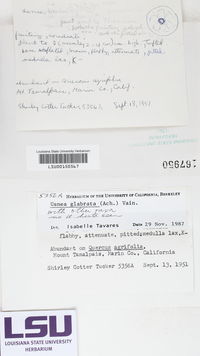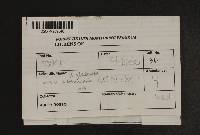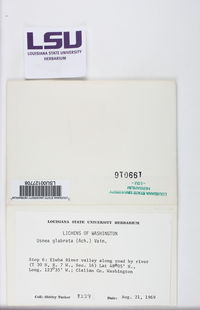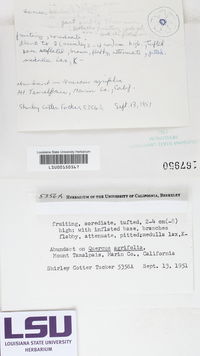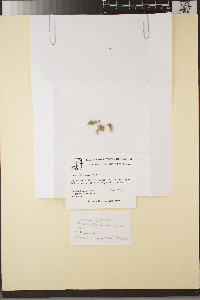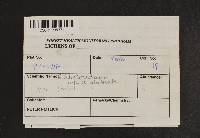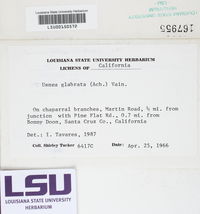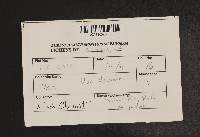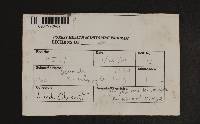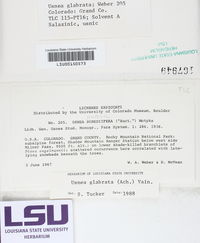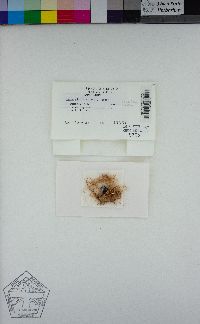
Consortium of Lichen Herbaria
- building a Global Consortium of Bryophytes and Lichens as keystones of cryptobiotic communities -
- Home
- Search
- Images
- Species Checklists
- US States: O-Z >
- US National Parks
- Central America
- South America
- US National Parks
- Southern Subpolar Region
|
|
|
|
Family: Parmeliaceae
[Parmelia barbata var. erecta Schaer., moreUsnea articulata f. erecta Stein, Usnea articulata f. glabrata (Ach.) Zahlbr., Cat. Lich. Univers. 6: 540 (1930), Usnea barbata f. erecta Schaer. nom. illegit., Usnea barbata f. sorediifera (Arnold) Arnold, Usnea barbata var. erecta Rabenh. nom. illegit., Usnea barbata var. sorediifera Arnold, Usnea erecta (Stein) Motyka, Usnea florida var. sorediifera (Arnold) Hue, Usnea hirta var. sorediifera (Arnold) Jatta, Usnea plicata f. erecta Kremp. nom. illegit., Usnea plicata f. glabrata (Ach.) Ach., Usnea plicata var. glabrata Ach., Usnea sorediifera (Arnold) Lynge, Usnea sorediifera f. sorediifera (Arnold) Lynge, Usnea sorediifera var. sorediifera (Arnold) Lynge] |
Nash, T.H., Ryan, B.D., Gries, C., Bungartz, F., (eds.) 2007. Lichen Flora of the Greater Sonoran Desert Region. Vol 3. Thallus: erect-shrubby, 2-5(-7) cm long branching: glossy on the surface, mostly anisotomic-dichotomous, divergent basal part: concolorous to branches or brown to black at the very base branches: ±inflated and fusiform, distinctly narrowed at attachment points, ±foveolate or with transverse furrows; apices: often thick and recurved segments: terete and ±sausage-like or irregular papillae: absent or indistinct and irregularly distributed, rarely abundant tubercles: absent fibercles: absent fibrils: absent to abundant, short (1-2 mm) and spinulous, irregularly distributed on the whole thallus soralia: broad, larger than half of diameter of branches, plane to excavate and exposing axis, circular to irregular, arising initially from the cortex, mainly on terminal branches and fibrils, often confluent and covering the whole extremities of the branches; soredia: granular isidiomorphs: absent pseudocyphellae: absent cortex: thin (3-5%) and smooth, shiny to vitreous medulla: usually thick, very loose, unpigmented axis: usually thin, unpigmented Apothecia: not seen Spot tests: K- brownish-greenish, C-, KC-, P+ orangish yellow to orange Secondary metabolites: medulla with protocetraric acid, ±fumarprotocetraric acid, ± diverse unknowns, ±fatty acids. Substrate and ecology: on bark of Quercus spp. and Pinus spp., and diverse scrubs in the chaparral or low oak and pine forests, between 0 and 500 m World distribution: circumpolar in boreal, temperate and Mediterranean regions of the Northern Hemisphere Sonoran distribution: coastal, southern California, including the Channel Islands. Notes: Usnea glabrata is a small species with very characteristic features: distinctly swollen branches and segments, large and excavate soralia without isidiomorphs, thin cortex and very lax medulla with protocetraric acid. |
Powered by Symbiota














